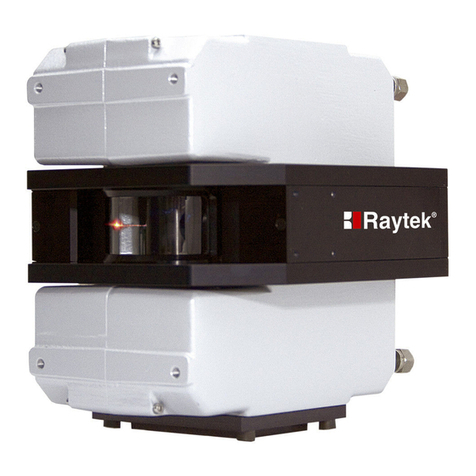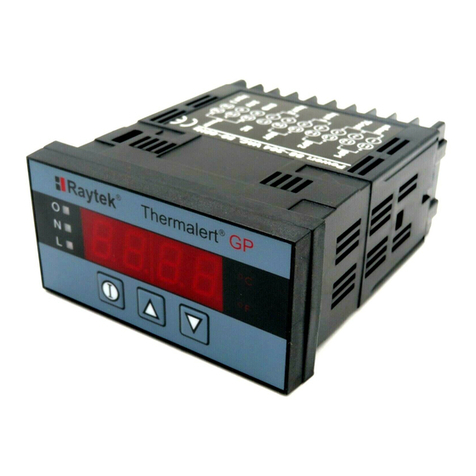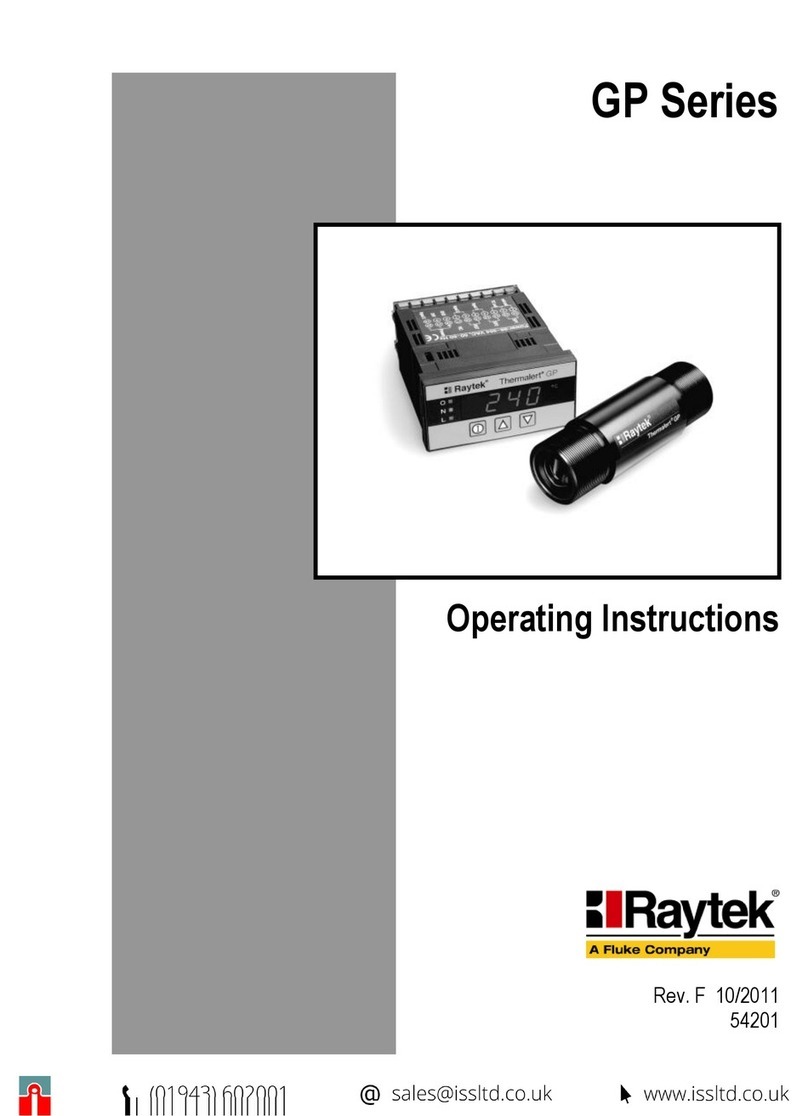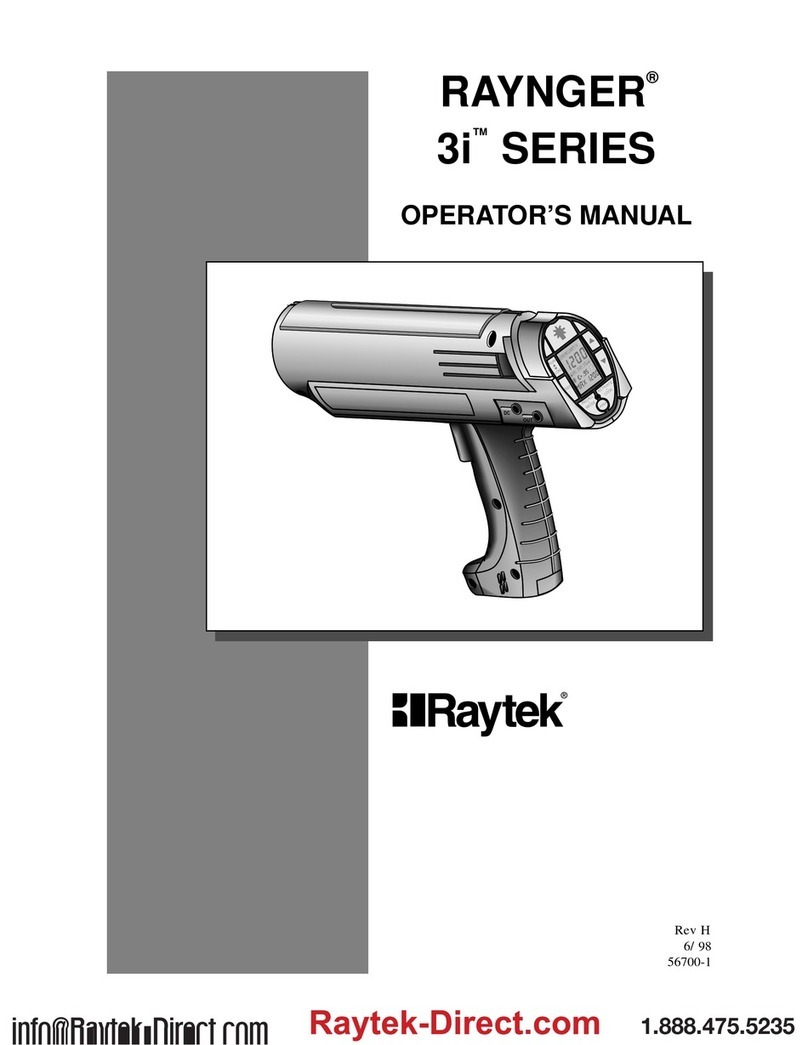
TWO YEAR LIMITED WARRANTY
Raytek warrants this product to be free from defects in material and workmanship under normal use and
service for a period of two years from date of purchase except as hereinafter provided. This warranty
extends only to the original purchaser (a purchase from Raytek or Raytek’s licensed distributors is an origi-
nal purchase). This warranty shall not apply to fuses or batteries. Factory calibration is warranted for a
period of one year. The warranty shall not apply to any product which has been subject to misuse, neglect,
accident, or abnormal conditions of operation or storage. Should Raytek be unable to repair or replace the
product within a reasonable amount of time, purchaser’s exclusive remedy shall be a refund of the purchase
price upon return of the product.
In the event of failure of a product covered by this warranty, Raytek will repair the instrument when it is
returned by the purchaser, freight prepaid, to an authorized Service Facility within the applicable warranty
period, provided Raytek’s examination discloses to its satisfaction that the product was defective. Raytek
may, at its option, replace the product in lieu of repair. With regard to any covered product returned within
the applicable warranty period, repairs or replacement will be made without charge and with return freight
paid by Raytek, unless the failure was caused by misuse, neglect, accident, or abnormal conditions of opera-
tion or storage, in which case repairs will be billed at a reasonable cost. In such a case, an estimate will be
submitted before work is started, if requested.
THE FOREGOING WARRANTY IS IN LIEU OF ALL OTHER WARRANTIES, EXPRESSED OR IMPLIED,
INCLUDING BUT NOT LIMITED TO ANY IMPLIED WARRANTY OF MERCHANTABILITY, FITNESS,
OR ADEQUACY FOR ANY PARTICULAR PURPOSE OR USE. RAYTEK SHALL NOT BE LIABLE FOR
ANY SPECIAL, INCIDENTAL OR CONSEQUENTIAL DAMAGES, WHETHER IN CONTRACT, TORT,
OR OTHERWISE.
WORLDWIDE
Raytek, Inc.
Billing: Box 1820, Santa Cruz, CA 95061-1820
Shipping: 1201 Shaffer Road, Santa Cruz, CA 95060
Phone: (408) 458-1110 (800) 227-8074 FAX: (408) 458-1239
EUROPE
Raytek GmbH
Arkonastrasse 45-49, D-13189 Berlin, Germany
Phone: 030/47 80 08-42 030/47 80 08-0 FAX: 030/47 10 25-1
JAPAN
Raytek Japan, Inc.
Sumitomo Marine Bldg., 2-27-15, Hon-Komagome, Bunkyo-ku, Tokyo 113, Japan
Phone: 03-5976-1531 FAX: 03-5976-1530
CHINA
Raytek China Company
Zhong Fa Investment Bldg., Ste. 221, 12 Jiu Xian Qiao Road, Chao Yang District, Beijing 100016 China
Phone: 86-10/6437-0284 FAX: 86-10/6437-0285
GREAT BRITAIN
Raytek UK Ltd.
P.O. Box 120, Milton Keynes, Buckinghamshire, MK1 1ZU, United Kingdom
Phone: 441-908/630800 FAX: 441-908/630900
BRASIL
Raytek do Brasil
Subsidiária da Raytek, Inc.
R. Francisco Paula Aquino, 13, Sorocaba – SP – Brasil CEP 18013 - 200
Phone: (0152) 27,6556 FAX: (0152) 27,1091
Raytek and Thermalert are registered trademarks and 3 is a trademark of Raytek Corporation
© Raytek Corporation 1996































